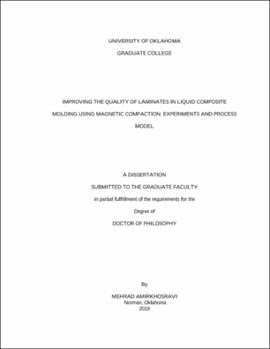| dc.description.abstract | Despite the extensive use of liquid composite molding (LCM) processes such as wet lay-up vacuum bagging (WLVB) and vacuum assisted resin transfer molding (VARTM) in composite manufacturing, they have two major drawbacks. First, the fiber volume fraction of the composite parts made by LCM is lower than those made under an elevated pressure using either autoclave or hot press, leading to lower mechanical properties. Second, the process induced defects in LCM parts are quite high, which may significantly reduce the mechanical performance and environmental durability of composites. The focus of this dissertation is to tackle the important problems encountered with WLVB and VARTM to improve the quality of molded parts.
The first part of this dissertation introduces a novel technique, magnet assisted composite manufacturing (MACM), to improve the quality of WLVB laminates. In this technique, the composite lay-up is sandwiched between a magnetic tool plate and a set of Neodymium-Iron-Boron (NdFeB) permanent magnets during cure. The details and effectiveness of MACM process are investigated by fabricating of E-glass/epoxy composite laminates with and without magnetic pressure and comparing their void content and morphology, fiber volume fraction, and mechanical properties. The results clearly show that the quality of composite laminates is significantly improved in the presence of magnetic consolidation pressure, where the fiber volume fraction increases by more than 50% to almost 30% and process-induced voids decrease to less than 3%. As a result, the flexural strength and modulus of the parts are enhanced by approximately 60% and 50% to ~245 MPa and ~10 GPa, respectively.
The second part of the dissertation extends the application of the MACM technique to fabricate high-quality VARTM laminates. In VARTM, unlike the WLVB process, the preform impregnation takes place under vacuum, which results in different mechanisms of void formation and different ranges of fiber content. Thus, enhancing VARTM is quite different than enhancing the WLVB process which provides the motivation to investigate the effectiveness of utilizing MACM in VARTM. In this regard, thin (i.e. 6-ply), as well as moderately thick (i.e. 12- and 18-ply) E-glass/epoxy laminates are fabricated by applying MACM either before or after infusion. The results prove the effectiveness of MACM in fabricating high-quality VARTM laminates where a fiber volume fraction of more than 50% and void content of less than 1% is achieved. In addition, a transient magnetic consolidation model is developed, predicting the final thickness and fiber volume fraction of the VARTM/MACM parts.
The third part of this dissertation introduces a novel technique of compacting dry fibrous reinforcement to control the resin flow rate, thus eliminating the void formation in VARTM parts. In this technique, the fibrous preform is compacted by either stationary or moving magnets prior to resin infusion. As a result, the pore size between the fabric layers and permeability are reduced, and the filling rate of resin into preform decreases. The results show that in the absence of magnetic pressure, the void content could be up to 5.7%, much higher than 0.1-0.8% voids in the laminates made by 0.2 MPa magnetic compaction. In addition, moving magnets with a smaller footprint over a larger vacuum bag surface is a feasible approach to apply compaction pressure on medium to large parts, thus dramatically decreasing their void content to below 1%. | en_US |
